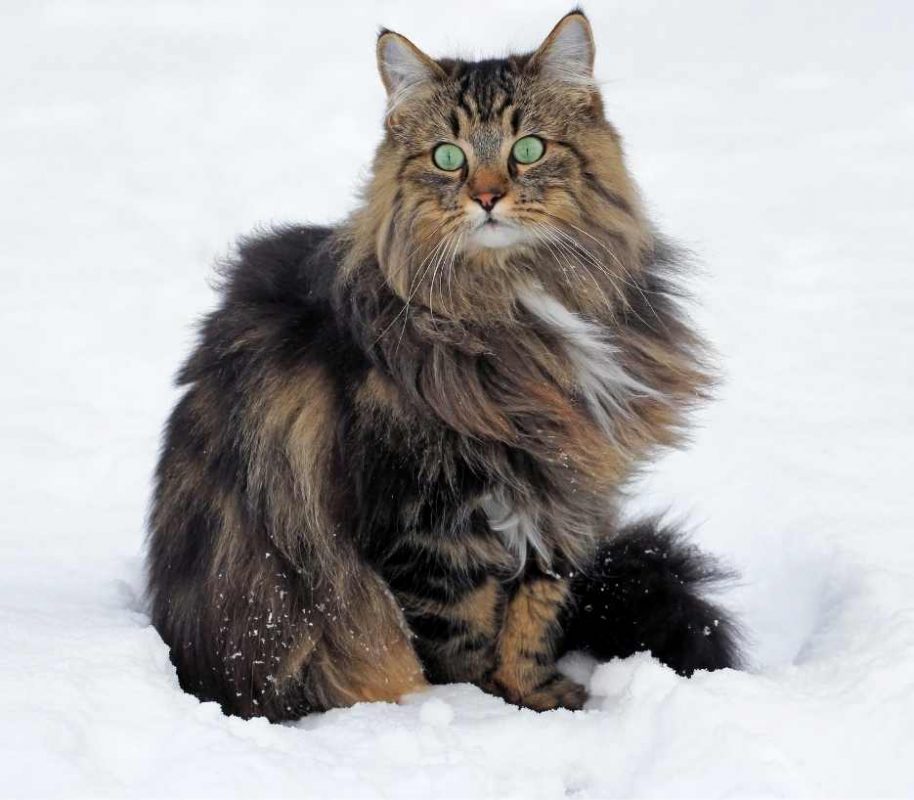
Meet the Norwegian Forest Cat, or “Skogkatt” as it’s known in Norway—a majestic, semi-longhaired feline that embodies both ruggedness and elegance. Despite their wild looks, these cats are homebodies who cherish the company of their human companions and other pets. Picture a cat that decides when to grace your lap with its presence, insisting on being near you in a spot of their choosing, be it a chair, bed, or desktop. They enjoy bursts of energetic play followed by long, restful naps. With their keen intelligence and social nature, Norwegian Forest Cats adapt readily to new environments and changes. While you might wonder if they need outdoor space, rest assured that they thrive happily and safely indoors with engaging toys, perches, and regular one-on-one time.
The Norwegian Forest Cat may be a relatively recent addition to the United States. Still, it’s a breed steeped in centuries-old folklore and mythology in Norway. The term “skogkatt” literally translates to “forest cat.” These cats are believed to have traveled with Viking explorers, keeping their ships rodent-free, just as they did in Norwegian barns. The breed faced near extinction due to hybridization with domestic shorthairs. Still, dedicated Norwegian cat enthusiasts revived and preserved the breed after World War II. The late King Olaf even designated them as Norway’s official cat. The first pair of Norwegian Forest Cats arrived in the U.S. in 1979, and the breed gained full championship status with the CFA in 1993.
Intelligent and resourceful, Norwegian Forest Cats are known for their mild-mannered and adaptable personalities. These gentle giants thrive on interaction and genuinely love being part of a family environment, seamlessly fitting into the household dynamic. They are playful and engaging, enjoying various games and activities with anyone willing to join in the fun, whether chasing after a feather toy or playing hide-and-seek. This breed’s social and affectionate nature makes them excellent companions, and they often form strong bonds with their human families. With their stunning, thick fur and tufted ears, they are as visually striking as they are loving, bringing joy and warmth to any home they inhabit.

At first glance, the Norwegian Forest Cat might resemble other semi-longhaired breeds like the Maine Coon. However, their look is uniquely distinctive with their large, almond-shaped eyes, equilateral triangle-shaped head, and heavily furnished ears. Their profile is straight from the brow ridge to the nose tip, adding to their striking appearance. Clad in an insulated, waterproof double coat designed for Scandinavian winters, they sport longer, coarse guard hairs over a dense undercoat. The full frontal ruff, bushy tail, rear britches, and tufted paws perfectly suit life near the Arctic Circle. Surprisingly, this coat is low maintenance and requires only weekly combing. Norwegian Forest Cats come in various colors and patterns, except for the colorpoint varieties found in Siamese or Persian-Himalayan breeds. Fully mature around age five, males weigh between 12 and 16 pounds while females range from 9 to 12.

Grooming
Norwegian Forest Cats are relatively low-maintenance. A weekly combing with a deep-tined or rotating-tined comb is usually enough. They shed minimally between their seasonal molts. Bathing is optional but safe with mild shampoo. Clip their nails monthly and clean their ears with veterinarian-recommended solutions if needed. Regular dental checks and weekly brushing will help prevent oral issues.
Nutrition
Most cats, including Norwegian Forest Cats, generally enjoy a balanced dry and wet food diet. Dehydrated raw food can also be a nutritious option. Avoid foods with by-products and fillers, opting for high-quality ingredients like chicken, beef, turkey, lamb, or salmon. Limit treats to no more than 10% of their diet, choosing high-quality options. Use stainless steel or ceramic bowls to prevent chin acne, and always provide fresh, clean water. Place the water bowl at least three feet from the food to encourage drinking.
Health
While Norwegian Forest Cats are generally healthy, they can be prone to genetic issues like hypertrophic cardiomyopathy (HCM), PK Deficiency, and Glycogen Storage Disease type IV (GSD-IV). Responsible breeders test for these conditions. HCM requires regular echocardiogram screenings since no DNA tests are available for this breed. Keep vaccinations and parasite treatments up to date.
Breeders typically make kittens available between 12 and 16 weeks of age. By this time, they have received basic inoculations and are ready for their new homes. When discussing a kitten’s price, consider the breeder’s investment in traveling to Europe for research and acquiring breeding cats, as well as the titles and preferred markings of the breed. Conversations with breeders should cover spay/neuter recommendations, feeding, and registration information. For more details, contact the Breed Council Secretary.
With their rich history, captivating looks, and engaging personalities, Norwegian Forest Cats make beautiful additions to any home. Whether you’re a seasoned cat lover or new to the feline world, these cats will win your heart.
Unleash the secrets to feline happiness! From picking the purr-fect breed to mastering grooming techniques and choosing the healthiest foods, we’ve got you covered. Get top-notch advice from world-renowned veterinarians, cat behaviorists, and groomers.
🐾 Visit our blog and become the ultimate cat parent! 🐾
Felinopedia is an online cat encyclopedia dedicated to sharing valuable information with (new) cat parents. We aim to help you give your furry friend the best tools and advice for a long, happy, and healthy life.
Join us on this journey to ensure your cat’s wellbeing.
Happy Cats, Happy Life